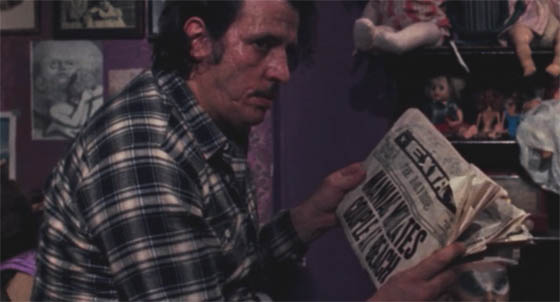 The late 70’s and early 80’s were the golden age of the slasher film, and by that I mean that a lot of slasher films were made – a lot – some of them good (The Burning), a scattered few of them great (Halloween, Black Christmas), and most of them terrible. They were spawned by the Italian giallo films, which wedded detective-mystery plots with stylish direction and grotesque violence, the most famous directed by Mario Bava and Dario Argento. The North American incarnation pared down its plots with a meat cleaver, and unless it was directed by Brian De Palma, it was typically a straightforward affair; if there was a twist, you could usually see it coming (well, except for Sleepaway Camp‘s, which is insane). Critics hated them, confused adolescent boys loved them, and I tell you all this that you already know only to frame the only unique identifier which marks Maniac (1980) in that “golden period” drenched in blood: it tells its slasher story from the killer’s point of view. That’s it. Oh, that and the killer is a mannequin fetishist. The film has a minor cult following, and near as I can figure it’s because of all those mannequins.
The late 70’s and early 80’s were the golden age of the slasher film, and by that I mean that a lot of slasher films were made – a lot – some of them good (The Burning), a scattered few of them great (Halloween, Black Christmas), and most of them terrible. They were spawned by the Italian giallo films, which wedded detective-mystery plots with stylish direction and grotesque violence, the most famous directed by Mario Bava and Dario Argento. The North American incarnation pared down its plots with a meat cleaver, and unless it was directed by Brian De Palma, it was typically a straightforward affair; if there was a twist, you could usually see it coming (well, except for Sleepaway Camp‘s, which is insane). Critics hated them, confused adolescent boys loved them, and I tell you all this that you already know only to frame the only unique identifier which marks Maniac (1980) in that “golden period” drenched in blood: it tells its slasher story from the killer’s point of view. That’s it. Oh, that and the killer is a mannequin fetishist. The film has a minor cult following, and near as I can figure it’s because of all those mannequins.
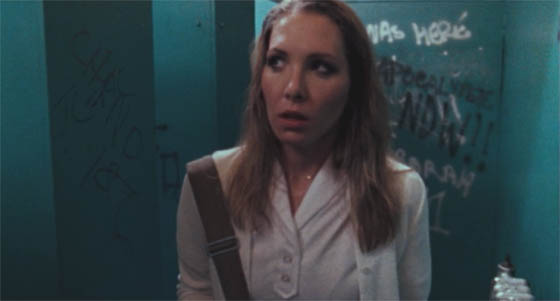
A nurse (Kelly Piper) tries to hide from the maniac in a subway restroom, while the graffiti suggests that perhaps you would enjoy "Apocalypse Now."
Actually, the film is a bizarre showcase for the prolific character actor Joe Spinell, whose credits include many of the major films of the 1970’s, including The Godfather: Part II (1974), Stay Hungry, Rocky, Taxi Driver (all 1976), and, perhaps most importantly, the David Hasselhoff masterpiece Starcrash (1978). Spinell co-wrote and stars in Maniac, playing Frank Zito, a psychopath who seems to be about sixty percent Son of Sam, twenty percent Ed Gein, and twenty percent Norman Bates. I know, I know – Psycho was inspired by Ed Gein, but Spinell does his best to channel Anthony Perkins, narrating several scenes with an interior monologue in which he pathetically whines to his dead, domineering mother; he also likes to kill women and scalp them, placing the bloody scalps on the heads of department store mannequins which he poses about his apartment. And that apartment: it screams “crazy,” but it doesn’t look like it could have possibly been decorated by Frank Zito. The walls are covered with drawings of grotesque monster-babies, partial faces sculpted out of plaster, naked baby dolls, the aforementioned mannequins posed at sharp angles so that they almost resemble jumping jacks, and – I don’t want to forget this – a Christmas wreath hanging on the door, right above the screaming plaster half-face. It looks like twenty-year-old students from NYU were holding some avant-garde art show in his dingy one-room dwelling; I don’t believe the working-class Spinell had anything to do with this. Except possibly the Christmas wreath, which really brightens the place up.
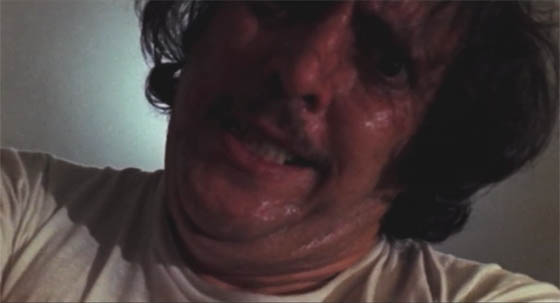
Joe Spinell, as Frank Zito, strangles a prostitute.
We’re introduced to Frank as he slits the throats of a couple cuddling in a sleeping bag on a beach during the pre-dawn hours. This is the kind of slasher film that pays special attention to how the blade cuts through the flesh, and how realistically the blood oozes. In other words, it’s a Tom Savini film – slasher’s makeup artist celebrity (Dawn of the Dead, Friday the 13th) was allowed to go wild on Maniac, most notably in his own death scene. Savini, playing “Disco Boy” (according to the end credits), is a heavily mustachioed dude who pulls to the side of the road – a good place to get killed – and delivers his single line of dialogue to his date: “Want to meet me some place? The back seat?” His eyebrows dance up and down like he’s Groucho Marx. Then they slip into the back and begin making out, until Frank Zito suddenly appears about one inch away from the window, breathing heavily. Disco Girl sees him, and says, “I see something!” As though there weren’t an extremely well-lit Joe Spinell one inch away from the window breathing heavily. They return to the front seat, but when Savini turns on the car’s headlights, Frank Zito appears clutching a shotgun. Then our killer leaps onto the hood of the car like a ninja and blows Disco Boy’s head off. In slow-motion, it explodes like a watermelon. One can almost hear Savini screaming “Yeeeeeaaaahh!” from off-camera while his dummy is reduced to a headless, gory mess.
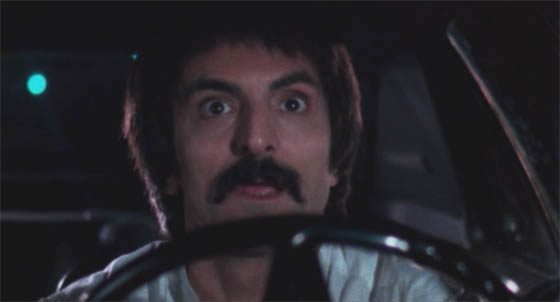
Tom Savini, as Disco Boy, seconds before death.
The next day, Zito goes to the park, where his photo is snapped at random by a fashion photographer, Anna D’Antoni (cult movie fave Caroline Munro, of The Golden Voyage of Sinbad, Captain Kronos Vampire Hunter, and The Spy Who Loved Me). He takes note of her name and address from a bag she leaves behind, and eventually tracks her back to her loft, pretending to be an artist with a shine to Anna’s photos. Anna is immediately smitten, and accepts his offer for a date, because come on – she’s Caroline Munro and he’s Joe Spinell: let the chemistry do its magic. If you had the body of a supermodel and a promising career in the fashion industry, and a stranger appears at your door, portly and with the complexion of a rock quarry, wouldn’t you immediately accept his invitation to dine at that neighborhood hot spot, the Clam Casino? Of course you would.
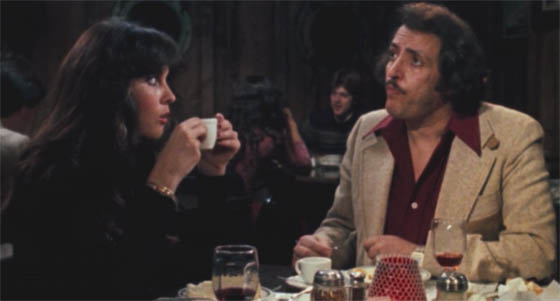
Caroline Munro and Joe Spinell enjoy a romantic evening at the Clam Casino.
This scene breaks a certain pattern which the film has been following for its first half: Zito finds a woman and immediate kills her, then finds another woman and immediately kills her. The inexplicable courtship actually follows a sustained setpiece in which Zito stalks a nurse through the New York subway; a scene that would be even more suspenseful if a continuity error didn’t cause all the commuters to instantly vanish from one shot to the next, leaving the poor nurse suddenly alone. (A possible theory is that the editor of the film is Zito’s accomplice.) So when Zito starts dating the photographer Anna, we can only wonder what he’s trying to accomplish – to steal that photo back? To actually get laid? But no: when he drops by her fashion shoot, he steals the gold necklace of one of the models: a convenient excuse to drop by that model’s apartment, tell her he found her necklace, and then knock her unconscious and drag her back to his place, where he kills her. We are back in the pattern again, and we’re treated to a scene in which he actually apologizes to one of his mannequins for getting blood all over its face as he attaches a new scalp. It’s interesting to me that he attaches the scalp by hammering in thumbtacks. A hot glue gun might have been more effective, but Frank prefers thumbtacks.
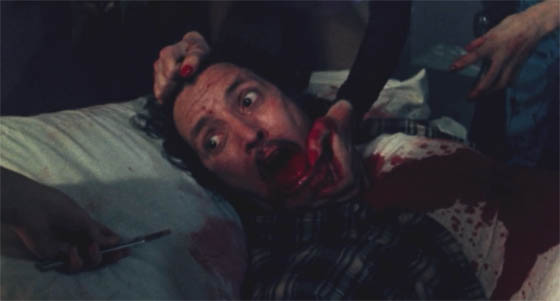
Frank Zito hallucinates that his mannequins come to life and take revenge.
Zito is also delusional – this may surprise you – and when Anna agrees to his impromptu suggestion they visit the cemetery before heading out for another dinner, he takes her to his mother’s grave and immediately regresses to a childlike state, begins sobbing, and then imagines that Anna is his wife Rita, whom he murdered, and wants to murder again. He chases her through a foggy cemetery while 80’s synthesizer music plays; when she successfully escapes, he collapses back at his mother’s tombstone and hallucinates that she returns as a zombie, bursting out of the earth and strangling him. It’s a rough night. He goes home, but now envisions that his mannequins have come to life, each of them representing one of his many murder victims. They pin him to the bed, stab him in the chest, and slice off his hand. The next morning, the police find Zito lying in a pool of blood upon the bed, apparently dead of a self-inflicted wound. Having better things to do, I gather, they immediate leave the scene without a single line of dialogue. This prompts a zoom upon Zito’s eye as it opens, and the word MANIAC flashes on the screen. (I would have preferred the-end-question-mark.) So there you have it. William Lustig directed. He made a few low-budget horror films before making a bigger mark with Blue Underground, a DVD and Blu-Ray boutique label of which he’s now CEO, releasing beautifully restored cult films. Maniac is one of the company’s releases, and it’s also available on Netflix streaming. Here’s the world’s most violent trailer (they even show the subway continuity error!)…









